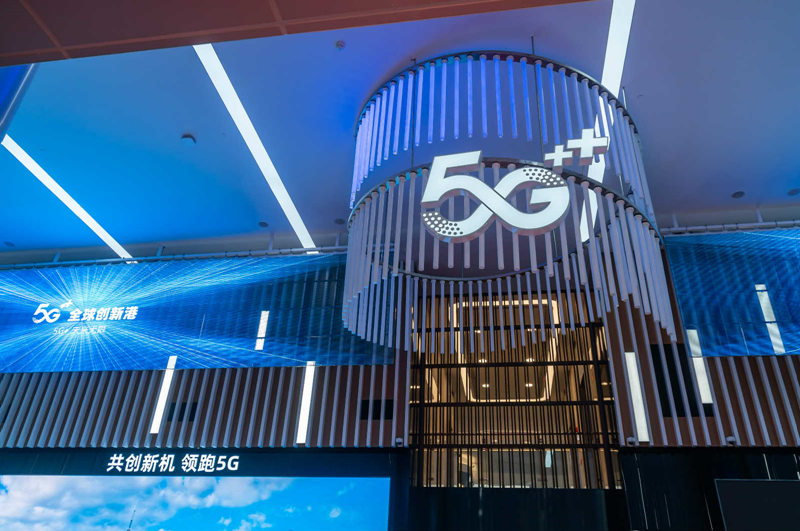China has pledged fresh efforts in advancing the construction of new infrastructure projects in a bid to further stimulate new consumption demand and boost industrial upgrading.
The country plans to issue 3.75 trillion yuan (about 529 billion U.S. dollars) of special local government bonds this year, up 1.6 trillion yuan from the previous year, with priority given to new infrastructure, new urbanization initiatives and major projects, according to a government work report submitted to the national legislature for deliberation on Friday.
Aerial photo taken on Oct. 10, 2019 shows a view of the Huaxi bus terminal equipped with charging facilities in Changxing County, east China's Zhejiang Province. (Xinhua/Xu Yu)
In terms of new infrastructure, China will develop next-generation information networks and expand 5G applications, said the report. Also, more charging facilities will be built to promote wider use of new energy vehicles.
Rather than resorting to a massive government-led stimulus to shore up growth, China is seeking more targeted investments in projects that facilitate innovation and improve weak areas in economic and social development.
The prioritized efforts are expected to not only boost consumption and benefit the people, but also facilitate structural adjustments and enhance the sustainability of growth, according to the report.
Take 5G as an example. China's investment in 5G network construction will reach 1.2 trillion yuan in aggregate by 2025, and is expected to leverage about 3.5 trillion yuan of investment in the upstream and downstream of the industrial chain as well as in other areas, according to the China Academy of Information and Communications Technology.
Moreover, total economic output indirectly driven by 5G businesses in China will hit 24.8 trillion yuan over the next five years, the academy predicted.
To grab the opportunities, local authorities have unveiled massive investment plans for new infrastructure projects including information networks and data centers.
Shanghai, for instance, announced that it will invest around 270 billion yuan in its first batch of 48 major new infrastructure projects in the next three years, focusing on the construction of new generation network, innovative infrastructure, artificial intelligence platforms and intelligent terminals.
In the period, the metropolis plans to set up 34,000 new 5G base stations and 100,000 smart charging piles for electric vehicles, along with unmanned factories, production lines and workshops.
Meanwhile, south China's Guangdong Province has arranged 1,230 major projects this year with a total investment of 5.9 trillion yuan, focusing on 5G telecom networks and inter-city transit systems.
Wen Bin, chief analyst at China Minsheng Bank, said construction of projects on 5G, Internet of Things, artificial intelligence and cloud computing, among others, is expected to stimulate economic vitality.
Industrial observers also noted that with the implementation of these projects, a batch of new infrastructure industrial clusters are expected to spring up.
In Guangzhou, the capital of Guangdong, authorities are planning to forge eight major industrial clusters centered on intelligent connected vehicles and smart robots, among others.
Next, China needs to move faster in putting in place related supplementary policies and widening fund-raising channels for the new infrastructure, said Zhou You, a researcher with the think tank CCID under the Ministry of Industry and Information Technology.
“New infrastructure” included in China’s government work report for first time
The concept of “new infrastructure” has been for the first time included in China’s government work report this year, which vowed to develop next-generation information networks and expand 5G applications, build more charging facilities and promote wider use of new-energy automobiles, and stimulate new consumer demand and promote industrial upgrading.

The photo taken on April 14 shows the 5G International Innovation Harbor at the North Bund waterfront in Hongkou district, Shanghai. (Photo by Wang Gang/People's Daily Online)
New infrastructure, together with new urbanization initiatives and major projects, will be given priority in the Chinese government’s efforts to expand effective investment this year.
How will the “two sessions,” annual meetings of the top legislature and political advisory body of China, chart the course for China’s development at this special time in history is a topic attracting worldwide attention.
Singaporean newspaper Lianhe Zaobao pointed out that economic “remedies” are definitely a major focus this year, as how China will set the tone for its economy and resume work and production is catching the eye of the world.
Now, solutions are revealed. Great expectations are placed on new infrastructure, new urbanization initiatives and major projects. They are taken as a priority because they are able to both address the current demand to offset the impacts of COVID-19 and help lay a foundation for digital economy and innovative development in the long run.
How will new infrastructure change our lives and the society? The government work report has given a clear answer – to develop next-generation information networks and expand 5G applications.
For consumers, 5G might mean faster internet speed, higher-definition videos, and faster downloads. However, 5G is more than those, and it will usher in an era of “new connection.” The broadband, less latency and high stability of the technology will further break the restrictions on people-to-people, people-to-things, and things-to-things connection, thus realize an internet of everything. 5G, like today’s power facilities, will become a key infrastructure in the future digital world, serving as a bedrock for digitalization of each industry.
Take health sector as an example. During the COVID-19 epidemic, 5G technology was used by Wuhan’s Leishenshan Hospital and the west campus of Wuhan Union Hospital to transmit CT images and other relevant treatment information to a command center in Beijing which dispatched corresponding medical experts from a “cloud” server to conduct comprehensive analysis on intractable cases. This method offered real-time assistance for medical workers saving lives on the frontline.
The technology of 5G features broad bandwidth, less latency and wide connection, which can perfectly fix the problems of remote diagnosis and treatment, such as delay, low video definition and stutters. Therefore, to realize wide connection of medical devices through 5G technology, promote online consultation of experts and optimize the allocation of medical resources is considered a qualitative leap in the medical world.
Not only the health sector, 5G will also be applied to the internet of vehicles, autopilot, industrial internet, smart homes, and smart cities. The “new connection” powered by 5G is inspiring indefinite imagination for the future.
Some compare data to mine, computing to electricity, and 5G, AI and cloud computing to light, TV and other appliances that present computing in a colorful manner, in the smart world of new infrastructure. To realize the imagination for the future digital world, “new connection” is only one of the many steps.
When 5G connects hundreds of industries, the world has to face gigantic waves of data. After all, an autopilot vehicle generates 64TB of data in a single day, which is able to fill 32 hard discs. Without supercomputing capability, these data cannot create their due value, let alone helping us make the production and decision systems more efficient and smarter.
In the future, huge data will be generated on terminals, edge and cloud, so computing must be completed where data are generated. Besides, computing capability must be diversified for terminals, edge and cloud. Only by doing this can the value of data be maximized and industrial digitalization be accelerated. So it’s obvious that new connection and new computing are core to new infrastructure.
Empowered by new connection and new computing, industries are now accelerating digital transformation, working in high speed to upgrade themselves.
In Xiamen, Southeast China’s Fujian Province, an all-scenario smart port is put into operation, which is expected to save over 10 million yuan ($1.4 million) of labor cost each year. In Shenzhen, 5G, cloud and AI technologies are applied to the construction of smart airports, reducing 20 percent of the waiting time for passengers, and freeing 4 million passengers from ferry buses each year. In Suzhou, East China’s Jiangsu Province, a smart water affair system powered by these technologies is making the city’s water clearer.
In the future, the development of new infrastructure will surely digitalize and upgrade the society at a higher speed, bringing us whole new experiences beyond imagination.
(Source: Xinhua, People's Daily)





